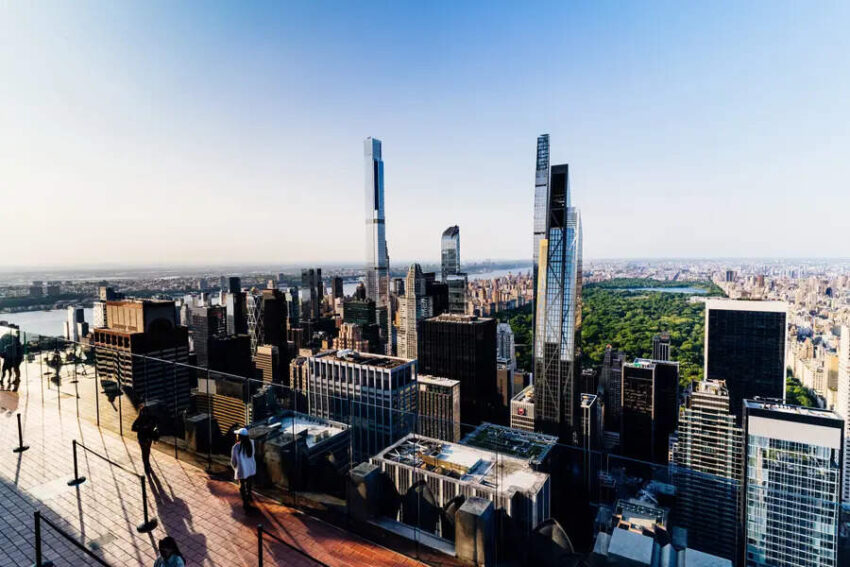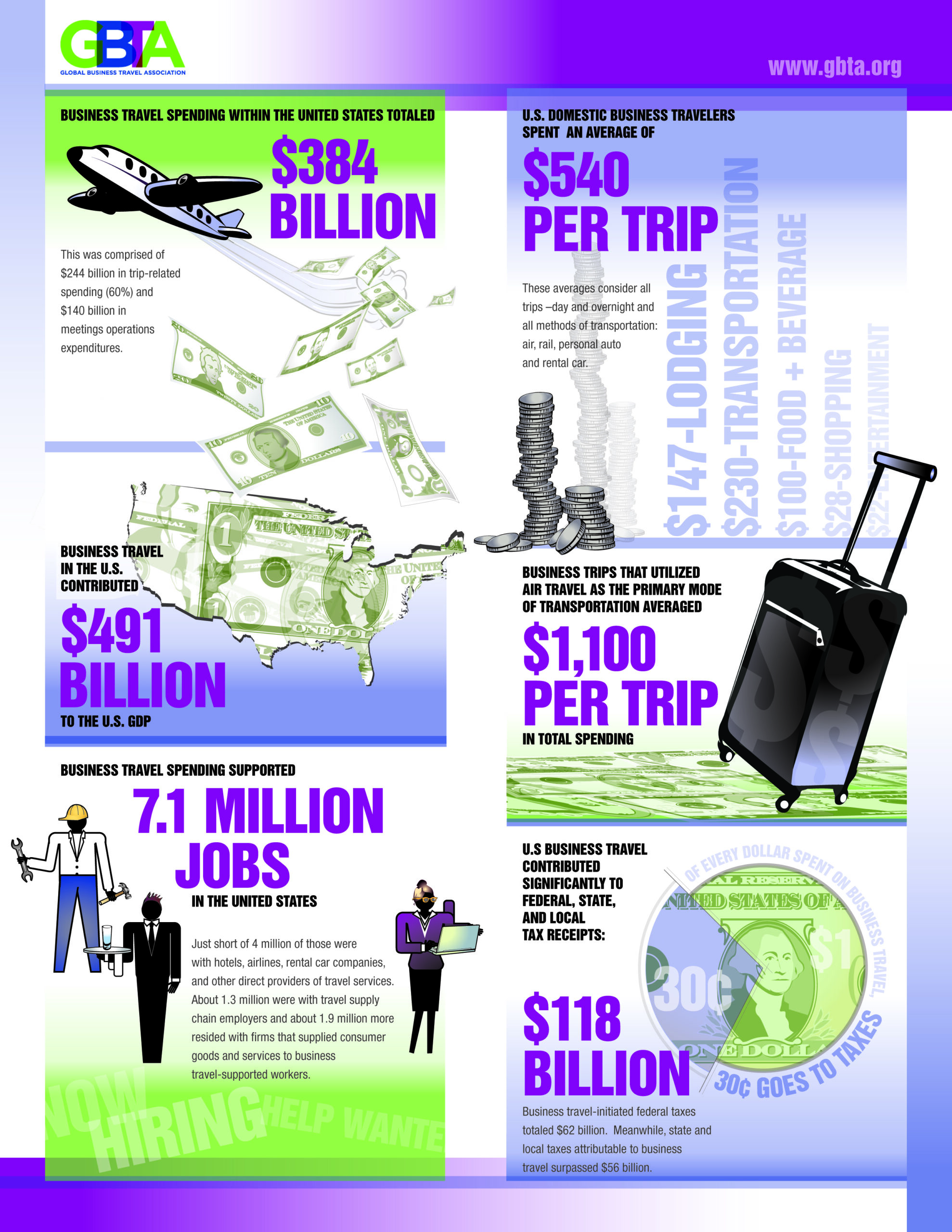The latest study by the Global Business Travel Association (GBTA) has highlighted the substantial economic impact of business travel in the United States. The “GBTA U.S. Economic Impact Study: Business Travel’s Impact on Jobs and the U.S. Economy” reveals that business travel was a key driver of economic health in 2022, the most recent full year with complete data. This sector accounted for 2% of the U.S. GDP and supported 3.5% of total employment, underscoring its critical role in the nation’s economic landscape.
Significant Economic Contributions
In 2022, the U.S. led the world in business travel spending, with expenditures totaling $421.1 billion USD. This spending generated $119 billion in tax receipts and supported six million jobs, representing 3.5% of the total U.S. employment. The economic benefits of business travel extend beyond immediate expenditures, with every dollar spent on business travel generating $1.15 in net-new gross domestic product (GDP) for the U.S. economy.
Employment Impact
The business travel industry supports a wide range of jobs, with the direct employment figures indicating a diverse impact across various sectors. Approximately 38% of the jobs supported by business travel were in food services, 19% in accommodations, and 11% in transportation and warehousing. This distribution highlights the interconnected nature of business travel with other critical segments of the economy.
Detailed Traveler Profiles
The study also delves into the characteristics, behaviors, motivations, and spending patterns of U.S. business travelers. On average, business travelers took 429.9 million trips within the U.S. in 2022. Of these trips, 67% were for transient purposes, including sales, client services, government and military travel, and construction or repair travel. The remaining 33% were for conferences and events. Notably, business travelers are now staying longer, with the average trip length increasing to 4.1 days in 2022 from 3.3 days in 2017.

Economic Model and Methodology
The GBTA’s economic impact study utilized a standard economic model to estimate the total annual business travel spending in the U.S. for 2022. This model translated business travel spending into its effects on GDP, jobs, wages, and taxes, providing a comprehensive overview of the industry’s economic contributions. The U.S. is projected to remain a leading market for business travel spending in 2024, with expectations of robust growth continuing.
Top Business Travel Destinations
The top 15 states for business travel spending accounted for 65% of the total U.S. expenditures. California and New York led the way with $35.62 billion and $23.31 billion in spending, respectively. The full list of top states included:
California:
California is a diverse state known for its iconic cities like Los Angeles, San Francisco, and San Diego. It offers stunning beaches, vibrant tech industry hubs, and famous attractions such as Disneyland, Hollywood, and the Golden Gate Bridge. The state’s natural beauty includes national parks like Yosemite and Sequoia.
New York:
New York, often referred to as New York State to distinguish it from New York City, is famous for the latter’s cultural and financial influence. NYC boasts landmarks such as Times Square, Central Park, and the Statue of Liberty. Upstate New York offers scenic landscapes, including the Adirondacks and Niagara Falls.
Florida:
Florida is renowned for its warm climate, beautiful beaches, and major attractions like Walt Disney World and Universal Studios in Orlando. Miami is known for its vibrant nightlife and cultural scene, while the Florida Keys offer a tropical paradise. The state is also home to the Everglades National Park.
Texas:
Texas is the second-largest state in the U.S., known for its rich history, diverse landscapes, and major cities like Houston, Dallas, and Austin. The Alamo in San Antonio and the NASA Space Center in Houston are notable attractions. Texas offers a unique blend of cultural heritage and modern amenities.
Georgia:
Georgia is a southeastern state known for its peaches, southern hospitality, and historical landmarks. Atlanta, the capital, is a major cultural and economic hub, home to the Georgia Aquarium and the Martin Luther King Jr. National Historical Park. Savannah offers charming cobblestone streets and historic architecture.
Illinois:
Illinois, located in the Midwest, is famous for its largest city, Chicago, known for its skyline, museums, and deep-dish pizza. The state also has rich agricultural areas and scenic landscapes like the Shawnee National Forest. Springfield, the state capital, is the home of Abraham Lincoln’s presidential library.
Colorado:
Colorado is renowned for its stunning Rocky Mountain landscapes, making it a haven for outdoor enthusiasts. Denver, the capital, offers a vibrant cultural scene with museums and breweries. The state is also famous for ski resorts such as Aspen and Vail, and natural attractions like Rocky Mountain National Park.
Pennsylvania:
Pennsylvania, rich in American history, is home to Philadelphia’s Liberty Bell and Independence Hall, where the Declaration of Independence was signed. Pittsburgh is known for its steel industry heritage and vibrant arts scene. The state also offers beautiful landscapes in the Pocono Mountains and Amish Country.
New Jersey:
New Jersey, known as the Garden State, offers a mix of urban and natural attractions. Atlantic City is famous for its boardwalk and casinos. The state has beautiful beaches along the Jersey Shore, and it’s close to major cities like New York and Philadelphia, providing diverse cultural and recreational activities.
Washington:
Washington State, located in the Pacific Northwest, is known for its diverse ecosystems, from coastal regions to mountains and forests. Seattle, its largest city, is famous for the Space Needle, Pike Place Market, and tech industry. The state is also home to natural wonders like Mount Rainier and Olympic National Park.
Arizona:
Arizona is celebrated for its desert landscapes and iconic natural wonders such as the Grand Canyon. Phoenix, the state capital, offers a vibrant urban experience with cultural attractions and golf resorts. Sedona is known for its red rock formations and spiritual vortexes, attracting numerous visitors.
North Carolina:
North Carolina offers a mix of coastal beauty and mountainous regions. Charlotte is a major financial hub, while Raleigh, the capital, is part of the Research Triangle known for tech and education. The Outer Banks provide stunning beaches, and the Blue Ridge Mountains offer scenic drives and hiking trails.
Ohio:
Ohio is a Midwestern state known for its diverse cities and rich history. Cleveland, on Lake Erie, offers cultural attractions like the Rock and Roll Hall of Fame. Columbus, the state capital, is known for its vibrant arts scene. Cincinnati boasts historic architecture and a strong German heritage.
Nevada:
Nevada is famous for its desert landscapes and vibrant entertainment scene in Las Vegas, known for its casinos, shows, and nightlife. Reno offers a smaller version of Vegas-style entertainment. The state also features stunning natural attractions like Lake Tahoe and the Valley of Fire State Park.
Virginia:
Virginia is rich in American history, home to historic sites like Colonial Williamsburg and Jamestown. The state offers diverse landscapes from the Blue Ridge Mountains to Atlantic beaches. Richmond, the capital, has a vibrant arts scene, while Northern Virginia is part of the Washington D.C. metropolitan area.
Nevada stood out with the highest ratio of business travel spending to GDP, with $6 billion in business travel expenditures comprising 3.2% of the state’s GDP.

Future Outlook and Policy Implications
Looking ahead, the U.S. is expected to maintain its position as a top market for business travel spending. The latest Global Business Travel Index™ (BTI) from GBTA predicts U.S. business travel spending in 2023 to increase by approximately 7% over 2019 levels, signaling a strong recovery for the industry. On a global scale, business travel spending is anticipated to surpass $1.5 trillion in 2024.
Importance of Sustainable Solutions
Suzanne Neufang, CEO of GBTA, emphasized the importance of considering the impact of business travel on the economy when formulating policies. She highlighted the need for sustainable solutions to address the challenges in the travel industry. “Business travel supports millions of jobs and delivers billions in tax revenue. It is crucial for policymakers to prioritize sustainable solutions to help mitigate the environmental impact of the travel industry’s hardest-to-abate sectors,” Neufang said.
Additional Highlights from the Study
The GBTA study provided several other key insights into U.S. business travel in 2022:
- Business travelers spent an average of $632 per trip, with lodging being the largest expense category at 34% ($214).
- The average age of U.S. business travelers was 44.3 years.
- Income distribution among business travelers showed that 33.9% had an annual household income below $50,000, 31.5% had incomes above $100,000, and the remaining third fell in between.
- “Bleisure” travel, where business and leisure trips are combined, accounted for over a third (33.8%) of all travel. On average, these trips lasted 4.4 days, and women were more likely than men to add a leisure component to their business trips.
The GBTA’s findings highlight the vital role of business travel in the U.S. economy. The industry’s contributions to GDP, employment, and tax revenue underscore its significance as a key economic driver. As business travel continues to recover and evolve, it remains essential for policymakers to support the sector and promote sustainable practices to ensure its long-term viability and positive impact on the global economy.
Tags: Business Travel, Business trips, California, Colorado,economic impact, Employment, Florida, GBTA GDP, Georgia, Illinois, New Jersey, New York,U.S. economy Virginia, Washington
